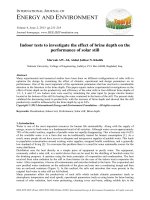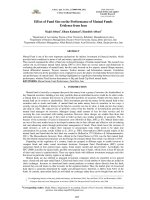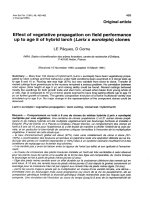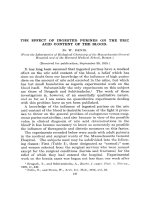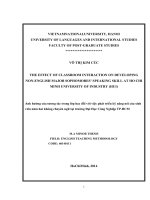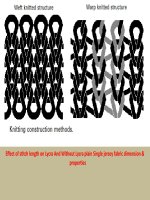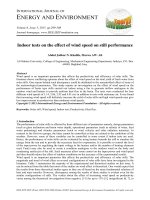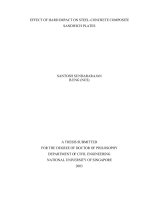Effect of quality of work life on job performance among power plant operators
Bạn đang xem bản rút gọn của tài liệu. Xem và tải ngay bản đầy đủ của tài liệu tại đây (1.26 MB, 45 trang )
UNIVERSITY OF ECONOMICS HO CHI MINH CITY
International School of Business
------------------------------
HA TUAN ANH
EFFECT OF QUALITY OF WORK
LIFE ON JOB PERFORMANCE
AMONG POWER PLANT OPERATORS
MASTER OF BUSINESS
Ho Chi Minh City – Year 2018
UNIVERSITY OF ECONOMICS HO CHI MINH CITY
International School of Business
------------------------------
HA TUAN ANH
EFFECT OF QUALITY OF WORK
LIFE ON JOB PERFORMANCE
AMONG POWER PLANT OPERATORS
MASTER OF BUSINESS
SUPERVISOR: PHAM NGOC THUY
Ho Chi Minh City – Year 2018
2
Introduction
Human resources are key firm resources (Tho, Phong, & Quan, 2014). Regarding people
at the workplace, quality of work life and the relationship between work and life have
received much attention in comparison with the other areas by researchers in the last few
years (Nguyen & Nguyen, 2012). This can be explained that “Quality of work life (QWL)
has attracted academics as well as practitioners because it affects job performance and
many other job factors (Lee et al., 2007; Sirgy et al. 2001; Wright 2010), and ultimately
the quality of life of employees (Nguyen and Nguyen 2012)” (as cited in Tho, 2018, p.
461).
Walton (1973) argues that QWL is a term that represents environmental and
human principles, but these are suspended because of the technological evolution and
economic development. And the most recent statistics indicate that the majority of the
working population is engaged in irregular or non-standard working hours, including shift
and night work, weekend work, split shifts (Costa, 2010). Costa (2010) explains that this
issue is related to the development of new technologies and the extension of basic
services to general populations, requiring continuous human assistance and control over
the work processes during the 24 hour day. And this issue is also associated with the
increasing economic competition among companies and countries, due to the progressive
globalization of the labor market and productive strategies, which entail an increasingly
intensive and extensive exploitation of productive systems.
Peters, Engels, de Rijk, and Nijhuis, (2015, p. 882) argue that “irregular work
schedules and working hours warrant specific attention, because both are linked to a wide
3
range of negative consequences, e.g. self-rated health, fatigue, work–home interference,
job satisfaction, decline in performance, and sick leave”. Hence, “improving adaptability
necessarily implies a focus on the human operator, the center of the manufacturing
processes” and “human quality of work intersection with production system performance
parameters, should be evaluated and optimized” (Layer, Karwowski, & Furr, 2009, p.
414).
The operators of the electrical power plants are among these population, who have
irregular working schedules and perform the activities which are characterized by
significant mental and psychosocial demands, such as the time pressure, responsibility,
amount of work, problem solving, decision-making, the high level of concentration
required and adjustment to new technologies and have to carry it out by mobilizing
knowledge and reasoning to which they have adequate training under the terms of the
existing rules (Silva, Marqueze, Rotenberg, Fischer, & Moreno, 2012).
The activities performed and services provided by the electric sector are essential
to the whole population, which is an important ingredient to the development of a
country, the electrical systems can be categorized as critical systems where failure can
result in significant financial loss, injury or threats to human life. For those power plant in
which the operators who have capability of making decisions quickly and effectively can
help the company to avoid fines and penalties by National Load Dispatch Center. Hence,
in order to survive and to create sustainable growth and development, the power plants
are required to have a new approach to management of the operators. Thus, understanding
factors that impact on operator performance and how these factors can influence operator
4
performance is paramount to effective management (Nguyen, Dang & Nguyen, 2015). In
this sense, this study aim to evaluate the impacts of QWL on job performance among
operators in power plants who have received little attention in Vietnam.
Literature review
Although the activities performed and services provided by the electric sector are
essential to the whole population, which is an important ingredient to the development of
a country, the electrical systems can be categorized as critical systems where failure can
result in significant financial loss, injury or threats to human life (Vitório, Masculo, &
Melo, 2012). However, for those power plant in which the operators who have capability
of making decisions quickly and effectively can help the company to avoid fines and
penalties by National Load Dispatch Center (Vitório et al., 2012). Hence, in order to
survive and to create sustainable growth and development, companies are required to
have a new approach to human resource management (Nguyen & Nguyen, 2012).
Pranee (2010) suggests that the most evident result of productivity improvement
regarding QWL for sustainable development is in the industrial sector, where various
improvements in applying technology and natural resources, as well as improvements in
human resources, have taken place. Furthermore, Bora, Das, and Murthy (2015) note that
by using QWL worker’s potential can be used to maximum extent. And, Korunka,
Hoonakker, and Carayon (2008), Rego and Cunha (2008) are all agreed that "QWL is
important for firms because it relates to employee performance productivity and loyalty”
(as cited in Nguyen & Nguyen, 2012, p. 88).
5
Quality of Work life
Kerce and Booth-Kewley (1993) argue that many authors have noted that workers are
becoming better educated and that they now consider work as a tool for personal growth
and social support rather than merely a means of achieving financial independence (as
cited in Martel & Dupuis, 2006). In order to explain how important QWL is, Sirgy,
Efraty, Siegel, and Lee (2001, p. 242) states that “there are some evidences showing that a
happy employee is a productive employee; a happy employee is a dedicated and loyal
employee; and QWL may have a significant impact on employee job performance”.
Walton (1973) and Pereira and Labegalini (2002) stands out that QWL is used to
assign innovative experiences carried through the attempt to rescue "ambient and
humanistic values neglected by the industrial societies in favor of the technological
advance, the industrial productivity and the economic growth"; and
attendance of the necessities and aspirations of the workers, including aspects related to a
bigger participation of the employee in the decisions, orienting itself in direction to the
industrial democracy, to the humanization of the work, emphasizing the social
responsibility of the companies
(as cited in Campos & Souza, 2006).
Although QWL may be viewed from different perspectives and has several
subcomponents, its various correlates that have been examined by different researchers
and generally consist of “a multitude of job and organizational attitudes and behaviors”
(Reilly, 2012, p. 5). In the context of this study, the author use eight subscales of Walton
(1973) to assess QWL, such as: Adequate and Fair Compensation, Safe and Healthy
6
Working Conditions, Immediate Opportunity to Use and Develop Human Capacities,
Opportunity for Continued Growth and Security, Social Integration in the Work
Organization, Constitutionalism in the Work Organization, Work and Total Life Space,
and Social Relevance of Work Life.
Walton (1973) defines eight variables of QWL are as in Table 1:
Content
Adequate and
Fair
Compensation
Definition
The major and initial impetus for employment is earning a living. How well that
aim is achieved fundamentally affects the quality of working. More than any other
criteria, adequacy of compensation is a relative concept and there simply is no
consensus on the objective or subjective standards for judging the adequacy of
compensation. Fairness in compensation, on the other hand, has various
operational meanings. Job evaluation specifies the relationships between pay and
factors such as training required, job responsibility, and noxiousness of working
conditions.
Safe and Healthy It is widely accepted in our society that workers should not be exposed to physical
Working
conditions or hourly arrangements that are unduly hazardous or detrimental to their
Conditions
health. Legislation, union action, and employer concern have resulted in
continually rising standards of satisfactory working conditions.
Immediate
The industrial revolution and a simplistic extension of its underlying logic have
Opportunity to
taken much of the meaning out of work. Work has tended to be fractionated,
Use and Develop deskilled, and tightly controlled. The planning of work has been separated from its
Human Capacities implementation. These tendencies have progressed in varying degrees from one
job to the next; therefore, jobs differ in how much they enable employees to use
and develop their skills and knowledge.
Opportunity for
Here the focus shifts from the job to career opportunities. Although the opportunity
Continued
for self-improvement through education and hard work has been considered a
Growth and
human birth right, the typical industrial job can now be completely learned within
Security
a few weeks or a few years, after which the blue-collar worker has reached nearly
the peak of his earnings and can look forward to only minor improvements.
Social Integration The preceding categories relate to the work's immediate and long-range
in the Work
opportunities of expressing and developing individual abilities. Since work and
Organization
career are typically pursued within the framework of social organizations, the
nature of personal relationships becomes another important dimension of the
quality of working life. Whether the worker has a satisfying identity and
experiences self-esteem will be influenced by the attributes in the climate of his
work place such as freedom from prejudice, egalitarianism, mobility, supportive
primary groups, community, and interpersonal openness.
Constitutionalism The labor unions have brought constitutionalism to the work place to protect
in the Work
employees from arbitrary or capricious actions by employers. In unorganized
Organization
employment, there are wide levels of variation in the extent to which the
organizational culture respects personal privacy, tolerates dissent, adheres to high
standards of equity in distributing organizational rewards, and provides for due
process in work-related matters. The following aspects of constitutionalism are key
elements in providing higher quality to working life: Privacy, free speech, equity,
7
Work and Total
Life Space
Social Relevance
of Work Life
due process.
The relationship of work to the total life space is best expressed by the concept of
balance. The balanced role of work is defined by work schedules, career demands,
and travel requirements that do not take up leisure and family time on a regular
basis. Likewise, balance refers to advancement and promotion that do not require
repeated geographical moves.
The socially beneficial roles of employing and the socially injurious effects of its
activities have increasingly become salient issues for employees. Organizations
which are seen to be acting in a socially irresponsible manner will cause increasing
numbers of employees to depreciate the value of their work and careers, which in
turn affects worker self-esteem.
Table 1. Definitions of QWL components
Job Performance
According to Austin and Villanova (1992), Campbell (1990), Murphy and Cleveland
(1995), Schmidt and Hunter (1992), “job performance is a central construct in
industrial/organizational psychology” (as cited in Viswesvaran and Ones, 2000, p. 216). It
can be explained that “virtually every measurable individual differences variable thought
to be relevant to the productivity, efficiency, or profitability of the unit or organization
has been used as a measure of job performance in the industrial/organizational
psychology literature” (Viswesvaran, 1993, p. 1). In this sense, Harari and Viswesvaran
(2017, p. 55) defines “job performance as evaluatable behaviors engaged in by employees
that contribute toward achieving organizational goals”.
Regarding to performance measurement, DeNisi and Sonesh (2011), Levy and
Williams (2004), Murphy and Dechert (2013), and Woehr and Roch (2012) agree that
performance ratings by supervisors, peers, subordinates, or by oneself are ubiquitous (as
cited in Campbell & Wiernik, 2015). After reviewing literature on job performance in last
15 years up to the point, Harari and Viswesvaran (2017, p. 59) argue that “several content
models of job performance have been postulated but despite the different terminology,
8
they are strikingly similar” and suggest that “a model of the job performance construct
need not vary with the zeitgeist”. Such a model is initially proposed by Viswesvaran
(1993), and consists 10 job performance dimensions that comprehensively represents the
entire job performance domain, such as: Overall job performance, Job performance or
productivity, Quality, Leadership, Communication competence, Administrative
competence, Effort, Interpersonal competence, Job knowledge, and Compliance with or
acceptance of authority.
Viswesvaran, Ones, and Schmidt (1996) defines ten job performance dimensions
are as in Table 2:
Content
Overall job
performance
Job performance
or productivity
Quality
Leadership
Communication
competence
Administrative
competence
Effort
Defenition
Ratings on statements (or ranking of individuals on statements) referring to overall
performance, overall effectiveness, overall job performance, overall work
reputation, or the sum of all individual dimensions rated.
Ratings of the quantity or volume of work produced. Raters' rating or ranking
individuals were based on productivity or sales; examples include ratings of the
number of accounts opened by bank tellers and the number of transactions
completed by sales clerks.
Measure of how well the job was done. Ratings of (or rankings of individuals on
statements referring to) the quality of tasks completed, lack of errors, accuracy to
specifications, thoroughness, and amount of wastage.
Measure of the ability to inspire, to bring out extra performance in others, to
motivate others to scale great heights, and professional stature; includes
performance appraisal statements such as "gets subordinates to work efficiently,"
"stimulates subordinates effectively," and "maintains authority easily and
comfortably."
Skill in gathering and transmitting information (both in oral and written format).
The proficiency to express, either in written or oral format, information views,
opinions, and positions. This refers to the ability to make oneself understood;
includes performance appraisal statements such as "very good in making reports,"
"reports are clear," "reports are unambiguous," and "reports need no further
clarification."
Proficiency in handling the coordination of different roles in an organization. This
refers to proficiency in organizing and scheduling work periods, administrative
maintenance of records (note, however, that clarity is under Communication
competence above), ability to place and assign subordinates, and knowledge of the
job duties and responsibilities of others.
Amount of work an individual expends in striving to do a good job. Measure of
initiative, attention to duty, alertness, resourcefulness, enthusiasm about work,
9
Interpersonal
competence
Job knowledge
Compliance with
or acceptance of
authority
industriousness, earnestness at work, persistence in seeking goals, dedication,
personal involvement in the job, and effort and energy expended on the job
characterize this dimension of job performance.
Ability to work well with others. Ratings or rankings of individuals on cooperation
with others, customer relations, working with co-workers, and acceptance by
others, as well as nominations for "easy to get along with," are included in this
dimension.
Measure of the knowledge required to get the job done. Includes ratings or
rankings of individuals on job knowledge, keeping up-to-date, as well as
nominations of who knows the job best and nominations of who keeps up-to-date.
A generally positive perspective about rules and regulations; includes obeying
rules, conforming to regulations in the work place, having a positive attitude
toward supervision, conforming to organizational norms and culture, without
incessant complaining about organizational policies and following instructions
Table 2. Definitions of job performance components
In electrical power plants, there are sets of processes, instruments and equipment
designed for the transmission, generation, distribution, and commercialization of electric
power. Power plant operators typically perform the following: control power-generating
equipment which may use any one type of fuel, such as coal, nuclear fuel, or natural gas;
read charts, meters, and gauges to monitor voltage and electricity flows; check equipment
and indicators to detect evidence of operating problems; adjust controls to regulate the
flow of power; start or stop generators, turbines, and other equipment as necessary. Their
activities are characterized by significant mental and psychosocial demands, such as the
time pressure, responsibility, amount of work, problem solving, decision-making, the high
level of concentration required and adjustment to new technologies and have to carry it
out by mobilizing knowledge and reasoning to which they have adequate training under
the terms of the existing rules. Based on definitions of job performance dimensions:
Quality to measure of how well the job was done, Interpersonal competence to measure of
ability to work well with others, Job knowledge to measure of the knowledge required to
10
get the job done, and Compliance with or acceptance of authority is a generally positive
perspective about rules and regulations, the author use quality, interpersonal competence,
job knowledge, and compliance with or acceptance of authority to assess individual job
performance.
Research model and Hypotheses
The research model is proposed as Figure 1.
Figure 1. Research model
QWL and JP-Quality. Compensation is a strategic component that is used to motivate
employee to achieve high performance (Larkin, Pierce & Gino, 2012). Promotions put
employees to jobs that are more suitable for their abilities and skills (Gibbons, 1997). And
if employees’ work-family life is balance, the happy employees might have higher
performance. Hence, employees work harder if they value monetary rewards and believe
11
that those awards result from their increased efforts and the desire of being promoted
encourages the good employees to exert extra efforts to achieve performance goals. With
that in mind, this study hypothesized that
H1. QWL positively affects the Quality.
QWL and JP-Job knowledge. The company is providing training facilities for their
employees to develop their special abilities for the particular job which help them to gain
knowledge and develop abilities and opportunity to develop abilities are considered to be
the job factors that motivates employees performance to attain the target (Chandrasekar,
2011). With that in mind, this study hypothesized that
H2. QWL positively affects the Job knowledge.
QWL and JP-Interpersonel competence. Working in a harmony environment where
employees are friendly and ready to help and interact with each other, and where
employers are supportive and treat everyone equally, can result in improved employee
performance as well as the performance of the whole organization. Haynes (2007) finds
the behavioral components of the office environment have the greatest impact on office
productivity. With that in mind, this study hypothesized that
H3. QWL positively affects Interpersonel competence.
QWL and JP-Compliance with or acceptance of authority. Kahn (1990) defined
psychological safety as the employee's "sense of being able to show and employ one's self
without fear of negative consequences to self-image, status, or career" (p. 708).
Dimensions of climate that are likely to be indicative of psychological safety include the
extent to which: (1) management is perceived as flexible and supportive and employees
12
feel they have control over their work and the methods they use to accomplish it, (2)
organizational roles and norms are perceived as clear, and (3) employees feel free to
express their true feelings and core aspects of their self-concepts in their work roles.
When employees perceive that the organization accommodates their psychological needs
in the workplace, they are likely to respond by investing time and energy in the work of
the organization (Brown & Leigh, 1996). With that in mind, this study hypothesized that
H4. QWL positively affects Compliance with or acceptance of authority.
Methodology
Procedure and sample
The research was conducted at 4 combined cycle power plants (gas, DO fuel) with 2,700
MW capacity in the South of Vietnam where 21 thermal power plants (gas, DO, coal fuel)
locate in with 14,208 MW capacity. It consisted of two phases: preliminary research and
main research. The preliminary research was conducted by a qualitative study which was
firstly in-depth interviewing with five expert who have at least five years’ experience in
power plant to check the clarity of the questionnaire (see Appendix 1 for the List of expert
and their comments) and secondly was pilot test with 20 respondents (see Appendix 2 for
The pilot test result), to make appropriate adjustments where it was necessary and to
ensure the Vietnamese questionnaire version be understood by most respondents; that
contributed to the improvement of the official version.
In the main quantitative one, the modified questionnaires were used for the survey
to collect data aimed at testing the measurement model and structural model. Relating to
sample, the nonprobability sampling technique - convenience sampling approach was
13
conducted and data was collected through paper survey of 204 operators. Research
process included the following steps as illustrated in Figure 2.
Figure 2. Research process
Measurement
A paper questionnaire was developed to collect data to validate the constructs and theory
pointed in the research framework. This questionnaire was firstly developed in English
(see Appendix 3), and was translated into Vietnamese (see Appendix 4) later. Based on the
result of preliminary study, the instruction in Thọ (2011) and the supervisor’s guideline,
the questionnaire was finalized in three parts (1) screening, (2) main, and (3) biodata with
the result in which the number of item was modified (deleting 1 item of “Opportunity for
Continued Growth and Security”, adding 1 item for “Job knowledge”), the items were rearranged to shorten the questions, and different five-point measurement Likert scales were
applied to independent and dependent variables to reduce the bias (see Appendix 5).
14
For QWL, 35 measuring items were borrowed from Walton (1973), which were
used in da Silva Timossi, Pedroso, de Francisco, and Pilatti (2008) (see Table 3). The
WLSEC18 item was deleted due to the misunderstanding in the meaning. The five-point
Likert scale was used (1 = “very dissatisfy”, 2 = “dissatisfy”, 3 = “neither dissatisfy nor
satisfy”, 4 = “satisfy”, 5 = “very satisfy”).
Components
Adequate and fair
compensation
Coding
WLCOM01
WLCOM02
WLCOM03
WLCOM04
Safe and Healthy
Working
Conditions
WLHSE05
WLHSE06
WLHSE07
WLHSE08
WLHSE09
WLHSE10
Immediate
WLHUM11
Opportunity to
Use and Develop WLHUM12
Human Capacities
WLHUM13
WLHUM14
WLHUM15
Opportunity for
Continued
Growth and
Security
WLSEC16
WLSEC17
WLSEC18
WLSEC18
Social Integration
in the Work
Organization
WLSIO19
WLSIO20
WLSIO21
Statements
o How satisfied are you with your salary (remuneration)?
o How satisfied are you with your salary, if you compare it to your
colleagues' salary?
o How satisfied are you with the recompenses and the participation in
results that you receive from the company?
o How satisfied are you with the extra benefits (alimentation, transport,
doctor, dentist, etc.) that your company offers to you?
o How satisfied are you with your weekly work journey (quantity of
worked hours)?
o According to your workload (quantity of work), how do you feel?
o According to the use of technology in your tasks, how do you feel?
o How satisfied are you with the salubrity level (work conditions) in
your workplace?
o How satisfied are you with the security equipment, individual and
collective protection provided by your company?
o Regarding tiredness that your work cause to you, how do you feel?
o Are you satisfied with the autonomy (opportunity to make decisions)
that you have at your work?
o Are you satisfied with the importance of the task/work/activity that
you do?
o Regarding the polyvalence (possibility to performance several tasks
and works) at work, how do you feel?
o How satisfied are you with your performance evaluation (awareness
of how good or bad have been your performance at work)?
o Regarding possibilities conferred (work responsibility given to you),
how do you feel?
o How satisfied are you with your opportunity of professional growth?
o How satisfied are you with the trainings you participate?
o Regarding the situations and the frequency that occur the resigning at
your work, how do you feel?
o Regarding the incentive that your company gives you to study, how
do you feel?
o Regarding the discrimination (social, racial, religious, sexual, etc.) in
you work, how do you feel?
o Regarding your relationship with your colleagues and bosses at
work, how do you feel?
o Regarding your team's and colleagues' commitment to work, how do
you feel?
15
WLSIO22
o How satisfied are you with the valorization of your ideas and
WLCON23
o How satisfied are you with the company for respecting the workers'
initiative at work?
Constitutionalism
in the Work
Organization
Work and Total
Life Space
Social Relevance
of Work Life
WLCON24
o
WLCON25
WLCON26
o
o
WLBAL27
o
WLBAL28
o
WLBAL29
WLSRL30
WLSRL31
WLSRL32
o
o
o
o
WLSRL33
o
WLSRL34
o
rights?
How satisfied are you with your freedom of expression (opportunity
to give opinions) at work?
How satisfied are you with the norms and rules at your work?
Regarding the respect to your individuality (individual characteristics
and particularities) at work, how do you feel?
How satisfied are you with the work influence on your family
life/routine?
How satisfied are you with the work influence on your possibilities
of leisure?
How satisfied are you with your schedule of work and rest?
Regarding the proud of performing your work, how do you feel?
Are you satisfied with the image this company have to society?
How satisfied are you with the communitarian integration
(contribution to the society) that the company have?
How satisfied are you with the services and the quality of products
that the company makes?
How satisfied are you with the human resources politic (the way that
the company treats the workers) that the company has?
Table 3. QWL measurement items
For JP, in this study, based on the definitions of components given by
Viswesvaran, Ones, and Schmidt (1996) and the research context, 16 items were used to
measure Quality, Interpersonal competence, Job knowledge, and Compliance with or
acceptance of authority (see Table 4) in order to assess job performance. A JPKNL45
item was added to fit the research context. The five-point Likert scale was used (1 =
“strongly disagree”, 2 = “disagree”, 3 = “neither disagree nor agree”, 4 = “agree”, 5 =
“strongly agree”).
Components
Quality
Interpersonal
competence
Coding
JPQUA35
JPQUA36
JPQUA37
JPQUA38
JPQUA39
JPINT40
JPINT41
JPINT42
Statements
o My job has been done well.
o My job has been done with lacks of errors.
o My job has been done accuracy to specifications.
o My job has been done with thoroughness.
o My job has been done with lacks of accidents.
o I have ability to work well with supervisor.
o I have ability to work well with crew’s members.
o I have ability to work well with co-worker.
16
Job knowledge
Compliance with
or acceptance of
authority
JPKNL43
JPKNL44
JPKNL45
o My job has been done with job knowledge.
o My job has been done with up-to-date knowledge.
o With my job knowledge, I can carry out the other crew’s member
JPAUT46
o
JPAUT47
o
JPAUT48
o
JPAUT49
o
JPAUT50
o
JPAUT51
o
position.
I generally have positive perspective about rules and regulations,
such as obeying the rules.
I generally have positive perspective about rules and regulations,
such as conforming to regulations.
I generally have positive perspective about rules and regulations,
such as having positive attitude toward supervision.
I generally have positive perspective about rules and regulations,
such as conforming to organizational norms and culture.
I generally have positive perspective about rules and regulations,
such as without incessant complaining about organization policies.
I generally have positive perspective about rules and regulations,
such as following instructions.
Table 4. Job performance measurement items
The methods of data analysis included testing Cronbach’s alpha using IBM SPSS
software, testing Confirmatory Factor Analysis (CFA) and Structural Equation Modeling
(SEM) using IBM AMOS software. CFA is data analyzing technique aiming to supply
confirmatory test of research measurement theory. And SEM is a set of statistical model
that combines multivariate technique and multiple regressions in order to simultaneously
investigate the wide range of interrelated relationship which was in hypothesized model,
including the relation between variables and factors or between latent constructs (Hair et
al., 2009).
Data analysis, Results, and Discussion
After data collection, total 204 responses were collected. However, only 198 responses
were qualified for data analysis process. 6 questionnaires were eliminated because they
were invalid (respondents just chose one option for all questions; missed to answer some
questions). Finally, 198 questionnaires were used as valid data for this research.
Scale reliability and validity
17
Firstly, Cronbach's alpha was used to test the internal consistency for each measurement
component separately in SPSS. The resulting Cronbach’s alpha values of all
measurement component ranged from .73 to .91, which was acceptable as higher than .7
(Pallant, 2005).
Then, CFA were used for all of constructs in research model, see Figure 3.
Figure 3. The Measurement Model combining All Latent Constructs Simultaneously
Unidimensionality is achieved when the measuring items have acceptable factor
loadings (≥ .6) (Nunnally, 1978). Items WLHSE7, WLHSE8, WLHSE9, WLSIO19 were
deleted due to its factor loading < .6.
18
Discriminant validity is achieved when the measurement model is free from
redundant items. In case AMOS identify the pair of redundant items in the model in term
of high Modification Indices, one of the items should be deleted or the correlated pair
should be set as “free parameter estimate” (Awang, 2012). Items WLHUM11, WLSRL32,
WLSRL34, and JPAUT47 were deleted and pair items WLCON23, WLCON26 was set as
“free parameter estimate” due to its high Modification Indices.
Awang (2012) states that the output of Standardized Residual Covariance could be
examined as a guideline to the “wellness” of the structural model. The residual
covariance is the difference between the sample covariance and the model-implied
covariance. The model is correctly specified if most of the standardized residuals are less
than two in absolute value. Items WLCOM03, WLHUM12, WLSEC17, WLCON25,
WLSRL33, JPQUA36, JPKNL45, and JPAUT50 were deleted due to its high
standardized residuals.
Composite Reliability with a value > .6 is required in order to achieve composite
reliability for a construct. The average percentage of variation as explained (AVE) by the
measuring items for a construct > .5 is required. Based on the result shown in Table 5,
components HSE, SEC, SIO were deleted due to its low AVE.
COMPONENT
CODE
AVE
CR
Adequate and fair compensation
COM
0.564
0.794
Safe and Healthy Working Conditions
HSE
0.446
0.707
Immediate Opportunity to Use and Develop Human Capacities
HUM
0.516
0.761
Opportunity for Continued Growth and Security
SEC
0.473
0.642
Social Integration in the Work Organization
SIO
0.447
0.708
Constitutionalism in the Work Organization
CON
0.596
0.815
Work and Total Life Space
BAL
0.695
0.872
19
Social Relevance of Work Life
SRL
0.680
0.809
Quality
QUA
0.693
0.900
Interpersonal competence
INT
0.551
0.786
Job knowledge
KNL
0.750
0.857
Compliance with or acceptance of authority
AUT
0.605
0.860
Table 5. Average Variance Extracted and Composite Reliability
Construct validity is achieved when the Fitness Indexes for a construct achieved
the required level. The fitness indexes and the level of requirement are as follow: Root
Mean Square of Error Approximation (RMSEA) < 0.08 (Browne & Cudeck, 1993),
Goodness of Fit Index (GFI) > 0.90 (Joreskog & Sorbom, 1984), Comparative Fit Index
(CFI) > 0.90 (Bentler, 1990), Tucker-Lewis Index (TLI) > 0.90 (Bentler & Bonett, 1980),
Chi Square/Degrees of Freedom (Chisquare/df) < 5.0 (Marsh & Hocevar, 1985) (as cited
in Awang, 2012). The final measurement model had a good fit to the data: Chi-square =
395.092; df = 287; Chisquare/df = 1.377; P = .000; GFI = .878; CFI = .965; RMSEA =
.044. The next step was to model this constructs into structural model for analysis using
SEM.
Structural Equation Modeling (SEM)
The purpose of applying SEM was to test whether the hypotheses proposed in the
literature review existed or not. The SEM results in the Figure 3 showed that the
theoretical model received an acceptable fit to the data: Chi-square/df = 1.487, GFI =
.861, TLI = .945, CFI = .952, RMSEA = .050. Based on the result, all measurements
index were good excepted GFI index with dissatisfied value.
20
Figure 4. The Standardized Regression Weights for the SEM
As shown in Figure 4, the standardized beta estimate for effect of QWL on QUA is
.51, while the standardized beta estimate for INT is .59, for KNL is .43, and for AUT is
.51. The value of coefficient of determination R2 is .26 for QUA, is .35 for INT, is .18 for
KNL, and is .27 for AUT. It indicates that the contribution of exogenous constructs QWL
in estimating the endogenous construct QUA is 26%, INT is 35%, KNL is 18%, and AUT
is 27%. The result in Table 6 shown that all of the regression weight values were positive
and significant (p < .001), and it supported all four hypotheses.
Hypothesis
H1
H2
H3
H4
Path
QWL JP-QUA
QWL JP-INT
QWL JP-KNL
QWL JP-AUT
β
.628
.835
.594
.748
S.E.
.125
.154
.129
.141
21
Result
C.R.
5.025
5.423
4.596
5.305
Conclusion
P value
.000
.000
.000
.000
Supported
Supported
Supported
Supported
Table 6. The Regression Weights for QWL in predicting QUA, INT, KNL, and AUT
Discussion
In the context of electrical power plant, number of operator is about one third of
total number of employees in the organization. While the operators have irregular
schedule, the rest employees have regular schedule. It might lead to the poor social
connection between operators and the others. Even in operational community itself, an
operator uses to communicate with screw member. This could be the reason that Social
Integration in the Work Organization component of QWL was eliminated from this
research.
As mentioned before, this research was carried in 4 combined cycle power plants.
In term of efficiency, safety and environment operation, combined cycle power plant is
better than the power plants with other technology (Langston, 2013). Hence, the sample
chosen in this research might not well represent the population of this research context. It
would effects the reliability of the survey’s result. It would also lead to the high
correlation between JP components whose residuals were set double head arrow in
between in order to achieve Model Fit indices in SEM excepted the GFI index.
Furthermore, this survey was conducting during the working time of the operators, which
would also effect the survey’s result because of the non-respond bias.
A power plant is a component of national electrical grid. In term of safety working
environment, a power plant has to strictly follow national regulation and standard (The
National Assembly, 2001, 2015). This could be the reason that Safe and Healthy Working
22
Conditions (HSE) component of QWL was eliminated from this research. Furthermore,
the items of HSE component borrowed from Walton (1973) do not have any content
regarding to working conditions and consequences of irregular working schedule of the
operator. Hence, the author suggests that HSE component should be modified and/or
added items which mention to irregular working schedule for further research conducted
in the power plant context.
Conclusion
The operators of any power plant can have a huge impact on the organization's
performance, even the national electrical grid stability. And QWL is considered as
important factor for power plant because it relates to operator performance.
The findings are generally consistent with those from previous studies on QWL
and job performance (Beh & Rose, 2007; Lau, 2000; Sirgy et al., 2001), that QWL has
positive impacts on job performance of operators. Gavin and Mason (2004, p. 381) argue:
when a workplace is designed and managed to create meaning for its workers they tend to
be more healthy and happy. Healthy and happy employees tend to be more productive
over the long run, generating better goods and more fulfilling services for their customers
and the others with whom they interact and do business.
Power plants establishing an appropriate human resources management system that
enhances QWL for operators will benefit from their performance. In so doing, power
plants not only attend to pay and promotions but also create a good image, a positive
working environment that enhance operators’ satisfaction of Adequate and Fair
Compensation, Immediate Opportunity to Use and Develop Human Capacities,
23
Constitutionalism in the Work Organization, Work and Total Life Space, and Social
Relevance of Work Life, as found in this study.
References
Awang, Z. (2012). Structural equation modeling using AMOS graphic. Penerbit
Universiti Teknologi MARA.
Beh, L., & Rose, R. C. (2007). Linking QWL and job performance: Implications for
organizations. Performance Improvement, 46(6), 30-35.
Brown, S. P., & Leigh, T. W. (1996). A new look at psychological climate and its
relationship to job involvement, effort, and performance. Journal of applied
psychology, 81(4), 358.
Campbell, J. P. , & Wiernik, B. M. (2015). The modeling and assessment of work
performance. Annual Review of Organizational Psychology and Organizational
Behavior. Advance online publication. />Campos, L. C. A., & Souza, A. M. (2006). Study of the Walton’s criteria of quality of
working life using multivariate analysis in a military organization. In Proceeding
of the 3rd International Conference on Production Research.
Carson, K. P., Cardy, R. L., & Dobbins, G. H. (1991). Performance appraisal as effective
management or deadly management disease: Two initial empirical
investigations. Group & Organization Studies, 16(2), 143-159.
24
Chandrasekar, K. (2011). Workplace environment and its impact on organisational
performance in public sector organisations. International journal of enterprise
computing and business systems, 1(1), 1-19.
Choi, S., Leiter, J., & Tomaskovic-Devey, D. (2008). Contingent autonomy: Technology,
bureaucracy, and relative power in the labor process. Work and occupations, 35(4),
422-455.
Costa, G. (2010). Shift work and health: current problems and preventive actions. Safety
and health at Work, 1(2), 112-123.
da Silva Timossi, L., Pedroso, B., de Francisco, A. C., & Pilatti, L. A. (2008). Evaluation
of quality of work life: an adaptation from the Walton’s QWL model. In XIV
Intenational Conference on Industrial Engineering and Operations Management,
http://pg utfpr edu br/dirppg/ppgep/ebook/2008/CONGRESSOS/Internacionais.
Fielding, S. L. (1990). Physician reactions to malpractice suits and cost containment in
Massachusetts. Work and Occupations, 17(3), 302-319.
Fombrun, C., & Shanley, M. (1990). What's in a name? Reputation building and corporate
strategy. Academy of management Journal, 33(2), 233-258.
Frone, M. R., Russell, M., & Cooper, M. L. (1992). Antecedents and outcomes of workfamily conflict: testing a model of the work-family interface. Journal of applied
psychology, 77(1), 65.
Gavin, J. H., & Mason, R. O. (2004). The Virtuous Organization: The Value of Happiness
in the Workplace. Organizational dynamics, 33(4), 379-392.
25
